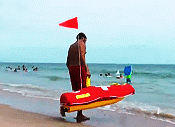 Lifeguard duty is the latest application
for radio-control systems and the combination of modern high-powered electric motors
and Li-Ion batteries. An Arizona-based company called
Hydronalix has created a robotic flotation
device to deploy to reach swimmers in distress when a lifeguard can't get there
soon enough. The robot is called EMILY, which is an acronym for Emergency Integrated
Life-saving Lanyard. EMILY weighs 25 pounds, can go up to 25 miles per hour and
can be used as a flotation device for up to six people. Its batteries will run the
device for about 15-20 minutes. Lifeguard duty is the latest application
for radio-control systems and the combination of modern high-powered electric motors
and Li-Ion batteries. An Arizona-based company called
Hydronalix has created a robotic flotation
device to deploy to reach swimmers in distress when a lifeguard can't get there
soon enough. The robot is called EMILY, which is an acronym for Emergency Integrated
Life-saving Lanyard. EMILY weighs 25 pounds, can go up to 25 miles per hour and
can be used as a flotation device for up to six people. Its batteries will run the
device for about 15-20 minutes.
The Hydronalix website does not have much information on it, but their About
Us page states, "Engineering and Design of high speed unattended devices for littoral
and brown water operations." Merriam-Webster dictionary defines of those two key
words thusly -
littoral: of, relating to, or situated on the shore of the sea or a
lake
brown water: an inland or coastal waterway esp. when murky or colored
brown by silt, tannins, or pollutants
The Hydronalix
website
page has a few photos and a some information on the operational testing. EMILY can
be dropped from helicopters or launched from a shoreline, a pier, or watercraft.
It has the ability to quickly get into hazardous areas where human rescuers would
typically take much longer to safely reach. Although not addressed on the website,
EMILY might also have an application in rescuing people who have fallen through
ice.
With a price tag of $10,000, EMILY does not come cheaply. Early models on special-purpose
items like this are usually expensive because of low Volume production and the need
to absorb the cost of development and certification. Liability insurance is probably
also a big part of the price as well. After all, no person or company, regardless
of the good intentions, is safe from the wiles of money-grubbing lawyers who will
exploit any situation.
Time Magazine chose it as one of the 50 best inventions in 2010.
|